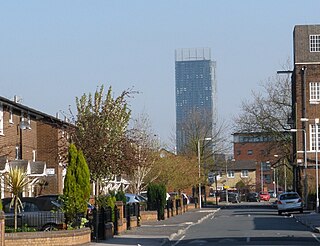
Chorlton-cum-Hardy is a suburban area of Manchester, England, three miles (4.8 km) southwest of the city centre. Chorlton ward had a population of 14,138 at the 2011 census, and Chorlton Park 15,147.

Rusholme is an area of Manchester, England, two miles south of the city centre. The population of the ward at the 2011 census was 13,643. Rusholme is bounded by Chorlton-on-Medlock to the north, Victoria Park and Longsight to the east, Fallowfield to the south and Moss Side to the west. It has a large student population, with several student halls and many students renting terraced houses, and suburban houses towards Victoria Park.

Fallowfield is a suburb of Manchester, England, with a population at the 2011 census of 15,211. Historically in Lancashire, it lies 3 miles (5 km) south of Manchester city centre and is bisected east–west by Wilmslow Road and north–south by Wilbraham Road. The former Fallowfield Loop railway line, now a cycle path, follows a route nearly parallel with the east–west main road.

Moss Side is an inner-city area of Manchester, England, 1.9 miles (3.1 km) south of the city centre, It had a population of 18,902 at the 2011 census. Moss Side is bounded by Hulme to the north, Chorlton-on-Medlock, Rusholme and Fallowfield to the east, Whalley Range to the south, and Old Trafford to the west.

Chorlton-on-Medlock is an inner city area of Manchester, England.

Hulme is an inner city area and electoral ward of Manchester, England, immediately south of Manchester city centre. It has a significant industrial heritage.

Burnage is a suburb of the city of Manchester in North West England, about 4 miles (6.4 km) south of Manchester city centre and bisected by the dual carriageway of Kingsway. Within the boundaries of the historic county of Lancashire, the population of the Burnage Ward at the 2011 census was 15,227. It lies between Withington to the west, Levenshulme to the north, Heaton Chapel to the east and Didsbury and Heaton Mersey to the south.
Whalley Range is an area of Manchester, England, about 2 miles (3.2 km) southwest of the city centre. The population at the 2011 census was 15,430. Historically in Lancashire, it was one of the earliest of the city's suburbs, built by local businessman Samuel Brooks.

Seddon Atkinson Vehicles Limited, a manufacturer of large goods vehicles based in Oldham, Greater Manchester, England, was formed after the acquisition in 1970 of Atkinson Vehicles Limited of Preston by Seddon Diesel Vehicles Limited of Oldham. In 1974, the firm was acquired by International Harvester, which sold it in March 1984 to the Spanish group Enasa which made it a subsidiary of Pegaso. In 1990, it became part of Iveco which used the brand for various types of specialised vehicles in the United Kingdom. The range of models produced included EuroMover, Pacer and Strato, which are aimed at refuse collection, recycling and construction operators.

Chorlton is a stop on the South Manchester Line (SML) and Airport Line of the Metrolink light-rail system in Chorlton-cum-Hardy, Manchester, England. It was built as part of Phase 3a of the network's expansion, and opened on 7 July 2011 on a section of the former Cheshire Lines Committee railway.

The Church of the Holy Name of Jesus on Oxford Road, Manchester, England was designed by Joseph A. Hansom and built between 1869 and 1871. The tower, designed by Adrian Gilbert Scott, was erected in 1928 in memory of Fr Bernard Vaughan, SJ. The church has been Grade I listed on the National Heritage List for England since 1989, having previously been Grade II* listed since 1963.

Charles H Roe was a Yorkshire coachbuilding company. It was for most of its life based at Crossgates Carriage Works, in Leeds.
Sociedad Española de Importación y Distribución de Automóviles was a Spanish cars and trucks dealer and coachbuilder that later evolved into making integral chassisless motorcoaches, and that in 1998 was subsumed into Evobus.

Chorltonville is a garden village in Chorlton-cum-Hardy, Manchester, England. It retains much of its original character, including architecture inspired by the Arts and Crafts movement.

The Wilmslow Road bus corridor is a 5.5-mile-long section of road in Manchester that is served by a large number of bus services. The corridor runs from Parrs Wood to Manchester city centre along Wilmslow and Oxford Roads, serving Didsbury, Withington, Fallowfield and Rusholme.

Between 1901 and 1949 Manchester Corporation Tramways was the municipal operator of electric tram services in Manchester, England. At its peak in 1928, the organisation carried 328 million passengers on 953 trams, via 46 routes, along 292 miles (470 km) of track.

Portland Street is a street which runs from Piccadilly at its junction with Newton Street southwards to Oxford Street at its junction with Chepstow Street in Manchester, England. The major buildings of Portland Street include the largest former warehouse in the city centre, Watts Warehouse, the former Bank of England Building and other former warehouses on the corners of Princess Street.
Holy Trinity was an Anglican parish church built in Hulme, Manchester in 1841 to a design by George Gilbert Scott and S. Moffat. Construction cost around £18,000 and was funded by Eleanora Atherton, the granddaughter of Edward Byrom, who had himself founded St John's Church, Manchester. The church was on Stretford Road, to the east of Hulme town hall.

Longwell Green Coachworks, formerly W. J. Bence & Sons and then Bence Motor Bodies Ltd, was a vehicle manufacturer based in Longwell Green, Bristol, England. It built the bodies of buses, coaches, vans and lorries on chassis supplied by other manufacturers. The company was in business from 1919 until 1983.
















